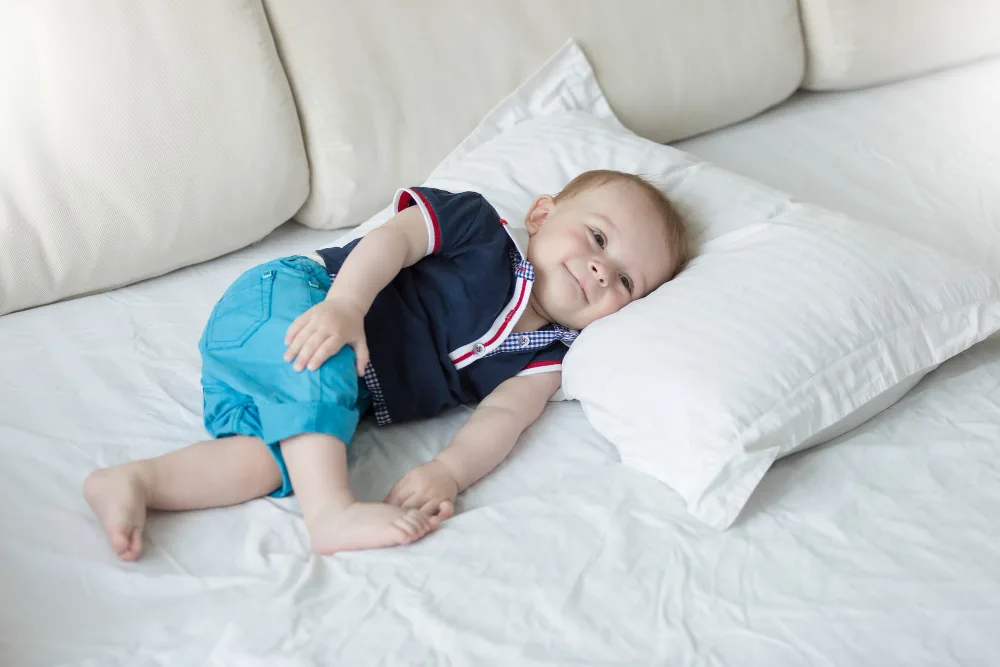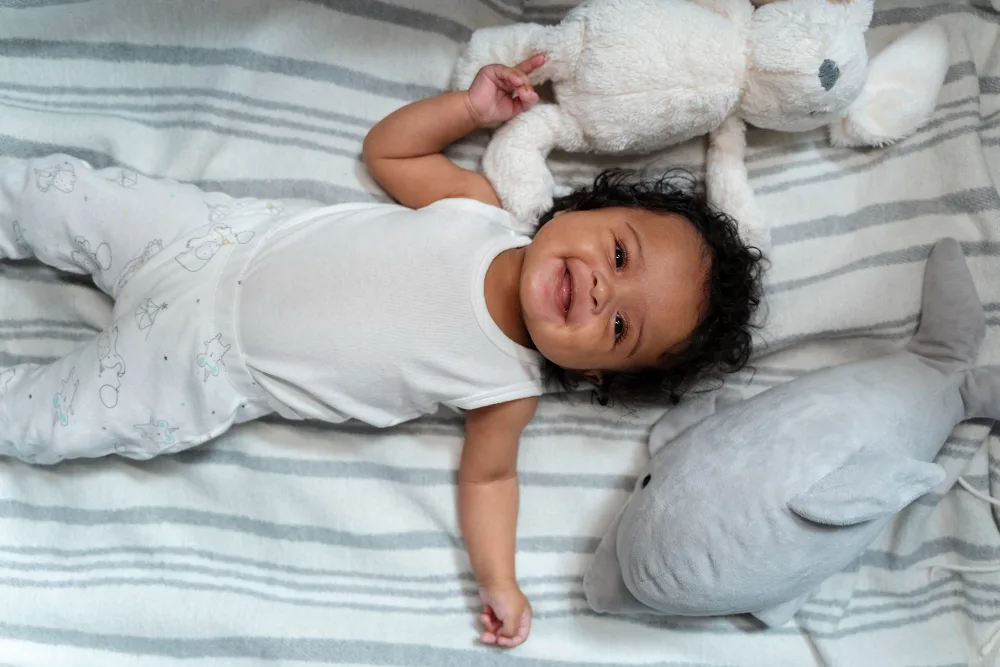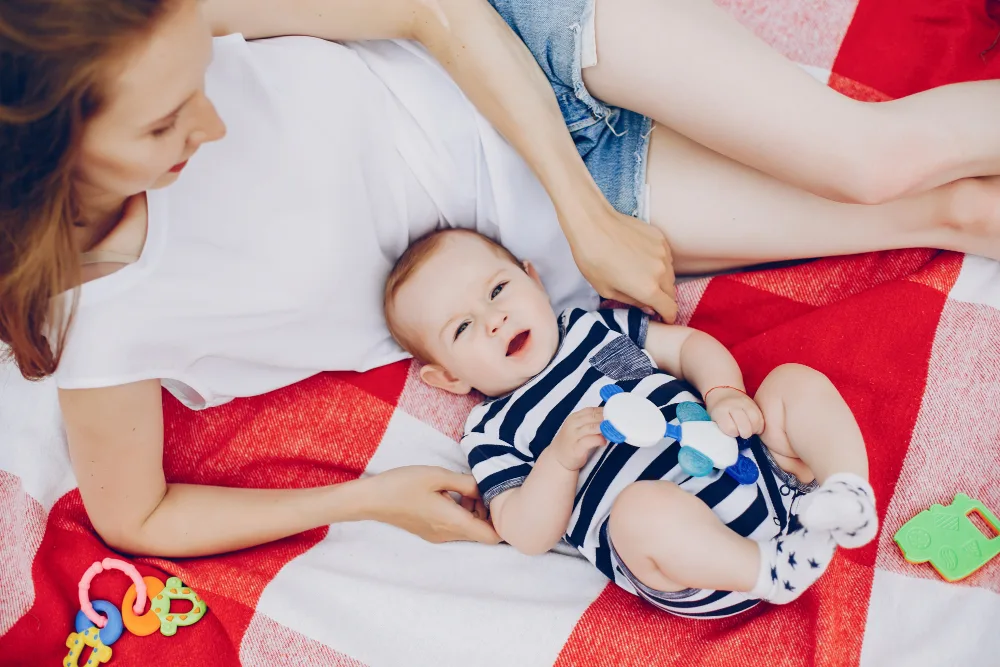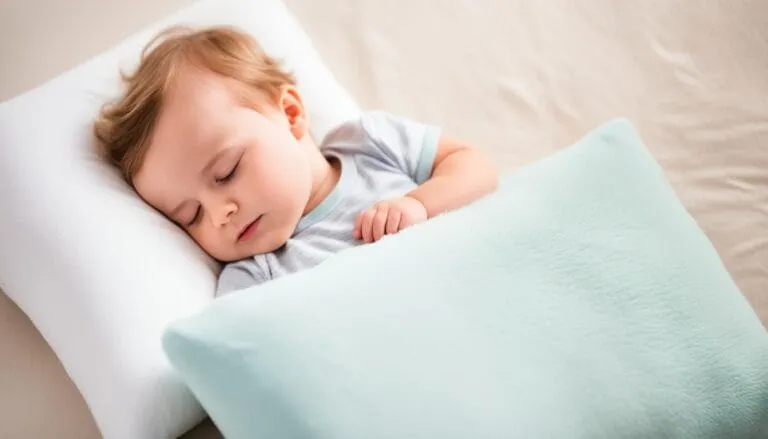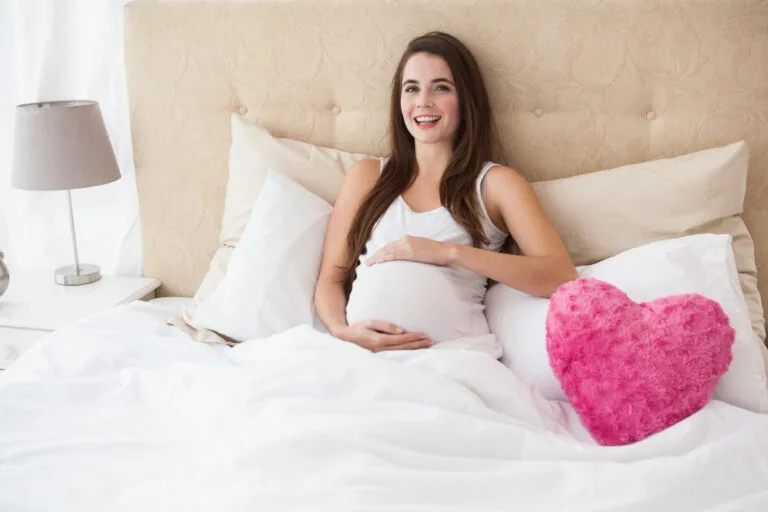Parents try their best to make sure their baby sleeps well and safely. There’s a big focus on the right sleep environment for little ones to avoid risks like suffocation and SIDS. The American Academy of Pediatrics warns against using pillows for babies under two years old. This advice helps keep babies safe from sudden death while sleeping.
Until they are two, it’s best to avoid putting a pillow in your baby’s crib. But after the first birthday, some risks change. For example, if pillows are around, babies aged four to 12 months might choke. Plus, as they grow, children could use pillows to help them climb out of the crib. This is dangerous and could cause harm.
If you’re worried about flat head syndrome, there are things you can do. Try repositioning your baby’s head during sleep. Give them plenty of tummy time when they’re awake, and don’t let them lay on their back for too long.
When your child turns two, and it’s time for a pillow, choose carefully. Pick a small, firm one that’s right for how they sleep. This way, the pillow can be safe and comfy for your little one.
Key Takeaways
- Babies should sleep on a firm, flat surface free of pillows, blankets, and other soft bedding until at least age 1, per AAP guidelines.
- Research hasn’t clearly defined a completely safe age for introducing pillows after 12 months, but many experts recommend waiting until the child transitions to a toddler bed, typically between 18 months and 3 1/2 years.
- Pillows and other soft items in a crib elevate the risk of SIDS.
- The Safe Sleep for Babies Act prohibits the manufacturing and sale of crib bumpers in the U.S. due to their associated hazards.
- When introducing a pillow to a toddler, choose a flat, firm toddler-sized pillow instead of a soft, squishy adult-size one.
For more detailed information on safe sleep practices for infants, please visit What to Expect.
Introduction to Baby Sleep (Infant Sleep Recommendations)
It’s crucial to keep babies safe when they sleep. Guidelines from the American Academy of Pediatrics (AAP) warn against using pillows with infants. This is because pillows increase the risk of sudden infant death syndrome (SIDS) and suffocation. Infants between four and 12 months face a higher risk of death with a pillow present.
Some may say pillows are good to avoid flat head syndrome. But, experts recommend keeping the crib free of pillows and extra bedding. This is especially important for babies with conditions like infant torticollis, a cause of tight neck muscles. They are more likely to develop flat head syndrome.
Using a firm mattress and ensuring proper head positioning are key steps. Also, activities like tummy time help prevent flat head syndrome. By following these steps, parents can make sure their baby sleeps safely.
When children are older than two, they can safely use pillows. These pillows should be designed for various sleeping positions. Moving to a more comfy sleep setup should happen cautiously to keep the kid safe and cozy.
Why Babies Should Not Sleep With a Pillow
Many new parents wonder if it’s safe for babies to sleep with pillows. The answer is clear: wait until they are two years old. The American Academy of Pediatrics says not to use pillows before then.
Nursing pillows can also be risky. Infants might suffocate if they roll over or if the soft fabric covers their face. It’s important to avoid such pillows for the baby’s safety.
Some people think baby pillows help prevent flat head syndrome. But usually, tight neck muscles cause this, not the lack of a pillow. Severe cases might need physical therapy.
There are ways to help with flat head syndrome without using a pillow:
- Change the baby’s head position while sleeping
- Minimize the time spent on their back
- Vary crib positions
- Incorporate tummy time
Flat head issues can often fix themselves as babies get older.
Pillows can also be dangerous. Older children might use them to climb out of cribs and get hurt. So, it’s best not to use pillows for babies.
American Academy of Pediatrics Recommendations
The American Academy of Pediatrics (AAP) focuses on safe sleep for babies to lessen Sudden Infant Death Syndrome (SIDS) risks. They aim to create the best sleep conditions for infants.
Age Guidelines for Pillow Use
Babies shouldn’t use pillows until they are at least two years old, says the AAP. A safe sleep area for babies includes no pillows or soft stuff. This is to avoid suffocation, choking, and SIDS.
Risks of Early Introduction
Using pillows too soon can be dangerous. They can block a baby’s breathing, leading to suffocation. Babies can’t easily move away from pillow hazards.
This danger is why pillows must wait until a baby is older. Prevent them from climbing out of the crib and getting hurt. Following the pillow safety guidelines for babies can indeed save lives.
The AAP reviews over 160 studies and highlights the ABCs of sleep safety.
They say babies should sleep alone, on their backs, and in a crib. Use a firm mattress and avoid soft things that might cause breathing problems or suffocation.
It’s best for parents to room-share with their infants but not bed-share. Use a separate, safe sleep space like a bassinet. Sleeping close but apart reduces SIDS risks by half. Breastfeeding and prenatal care are also essential for lowering SIDS dangers.
To end, the AAP advice on pillow safety helps babies sleep safely. This cuts down serious health risks and supports good sleep practices.
When Can a Baby Sleep With a Pillow?
Many parents wonder, when can a baby sleep with a pillow? The American Academy of Pediatrics suggests waiting until a child is two years old. It’s safest not to give pillows to infants between four and 12 months.
Infants should not sleep with a pillow. This helps reduce the risk of dangers like SIDS. Always follow expert advice to keep your baby safe.
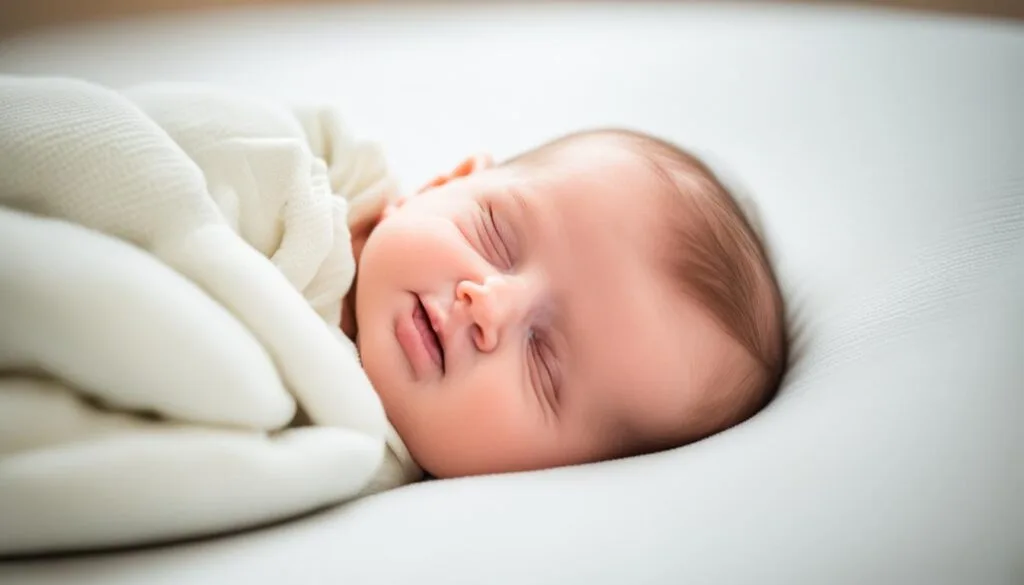
When your baby moves to a toddler bed, they might want a pillow for comfort. Wait until they’re at least 18 months old. Then, choose a small, firm pillow. This will help with their neck and support their head.
But be careful. Pillows and other things in a child’s bed can lead to accidents. Make sure the bed has only what’s needed for sleep.
Some parents worry about flat head syndrome from babies sleeping on their backs. A pillow is not the answer. There are safer ways to help, like changing the baby’s head position and giving tummy time.
Knowing when can a baby sleep with a pillow is important for parents. It’s about making choices that keep children safe. Guidance from groups like the American Academy of Pediatrics is key for a safe sleep area.
The Dangers of Other Bedding Items
The American Academy of Pediatrics says not to use soft bedding for babies. This includes pillows, blankets, and stuffed animals. Wait until your baby is 12 months old to give them these soft items. Early use can lead to suffocation or Sudden Infant Death Syndrome (SIDS).
Blankets and Stuffed Animals
Studies show that blankets and stuffed animals can add to the risk of SIDS. Between 1993 and 2010, fewer caregivers put blankets under babies. Cushion use also dropped. This shows people are learning about safe sleep. Babies should sleep on a hard, flat surface without these soft items.
Crib Bumpers
Many think crib bumpers are protective. But, they can cause suffocation and choking. More than 100 babies have died because of crib bumpers. The Safe Sleep for Babies Act, started in May 2022, has banned these items. It’s important to follow this law to keep babies safe.
Using pillows correctly for infants means waiting until they’re ready and in a toddler bed. This usually happens between 18 months and 3 1/2 years. Use a toddler pillow that’s flat and firm. These steps help avoid dangers and keep sleep safe for little ones.
- Safe sleep rules say to keep the crib clear of soft bedding until your baby is a year old.
- Take away crib bumpers to prevent danger; they are now banned by law.
- At the toddler bed stage, use proper toddler pillows that are flat and firm.
Debunking Myths: Flat Head Syndrome
Flat head syndrome, or plagiocephaly, happens when a baby’s head isn’t perfectly round. It might be flat in the back or on one side. This can be caused by the baby laying in the same position for too long. Sometimes, a condition called torticollis leads to this. It makes the baby’s neck muscles tight, affecting the head shape. Parents should know about the causes and how to prevent flat head syndrome.
What is Flat Head Syndrome?
Plagiocephaly, or flat head syndrome, means a baby’s head is not round. It looks uneven, usually because the baby lays on their back a lot. This puts pressure on one part of the head, making it flatter. Almost half of all babies get some kind of flat head. But, it doesn’t hurt how their brain grows.
Safe Practices to Prevent Flat Head
To stop flat head, focus on safe sleeping for babies. There are many safe ways for parents to help their baby without using pillows. Pillows are not safe for babies because of the risk of SIDS.
- Alternate Head Positions: Change which way your baby’s head faces each time they sleep. This stops the head from pressing in one place too long.
- Hold Your Baby Upright: Holding your baby often helps keep them off their back. It gives their head a break from lying down.
- Repositioning in the Crib: Switch what end of the crib your baby’s head is at. This changes where the head presses against the mattress.
- Tummy Time: Play with your baby on their tummy while they’re awake. It helps their muscles and takes pressure off their skull.
Never use pillows with babies because they can be dangerous. Even though pillows can seem good for shaping a baby’s head, experts say not to use them. The American Academy of Pediatrics warns against pillows in the crib. They recommend safe options, like the ones listed above, for your baby’s health and a good head shape.
Safe Sleep Practices for Newborns and Infants
It’s key to create a safe sleeping area for infants to prevent Sudden Infant Death Syndrome (SIDS). The American Academy of Pediatrics suggests keeping pillows away until babies are two. This step has cut SIDS cases by 80%, showing its importance.
A baby’s sleeping place should be firm and free of soft items, like pillows. This is vital from four to 12 months when the SIDS risk is highest. For older babies, pillows can be dangerous for climbing, leading to falls and injuries.
Many parents worry about flat head syndrome. But there are safe ways to prevent it. By changing a baby’s head position, doing tummy time, and moving the crib around, you can help. This also avoids issues like torticollis and the need for physical therapy.
Parents might wonder when it’s safe for babies to use pillows. Some flatness on the head is normal and usually fixes itself. Still, don’t give your child a pillow until they’re at least two and in a toddler bed, not a crib.
Good sleep safety goes beyond no pillows. Always lay babies on their backs to sleep. It’s best if they share a room but not a bed with you. Breastfeeding and using a pacifier also lower SIDS risks. These tips together keep your baby safer during sleep.
The Transition to Toddler Beds
Moving to a toddler bed usually happens between ages 1 and 3 1/2. It’s key to spot when your child is ready. This helps make the shift easy for them.
When to Make the Move
Babies often sleep in a crib until they’re 2 or older. But, waiting until they’re nearly 3 could make sleep time easier. You’ll know it’s time for a toddler bed when they start climbing out, or if they ask for one. Or, if they’re just too big for the crib, usually around ages 3 to 3 1/2. If a new baby needs the crib, or your child isn’t showing these signs, wait.
Setting Up a Safe Toddler Bed
Keeping baby safe in bed easily moves into the toddler stage. Start using a small, firm, and hypoallergenic pillow for good sleep. Add the right bedding too. This helps with their growth and cuts the risk of allergies.
Getting the room ready is also important. Remove anything dangerous. Keep the same bedtime habit. And, talk clearly about what you expect. Have a plan if they leave the bed. For extra help, you can join toddler sleep classes. They guide you through the steps of moving to a toddler bed and other sleep changes.
Choosing the Right Pillow for Your Toddler
Transitioning from a crib to a toddler bed marks an important time to choose the right pillow. It’s crucial for a safe and cozy sleep. You should start thinking about a pillow when your child is 2 years old. This step is key to lower risks such as SIDS and suffocation. The American Academy of Pediatrics and the Consumer Product Safety Commission advise against pillows for babies under 2. This ready advice comes from their higher risk of suffocation and climbing out of the crib.
Features of a Safe Pillow
Find a pillow that suits your toddler’s sleep style. Key points to think about are its size, how firm it is, and if it matches how your child sleeps. A flat, thin pillow is great for those who sleep on their back. For kids who sleep on their side, a firmer pillow that supports the head and neck is better. Make sure the pillow is not too big. It should provide support without causing strain on the neck and spine.
Hypoallergenic and Untreated Materials
Hypoallergenic and untreated pillows are best to avoid allergic reactions. These are perfect for kids with specific allergies or sensitivities. Look for brands like KeaBabies, Dreamtown Kids, and others. They’re known for making pillows with safe materials. Choosing these kinds of pillows helps parents ensure their baby sleeps well and safe.

